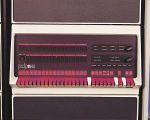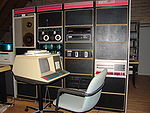Difference between revisions of "PDP-11/45"
| Line 1: | Line 1: | ||
[[Image:PDP11-45.jpg|150px|right|thumb|A PDP11-45]] | [[Image:PDP11-45.jpg|150px|right|thumb|A PDP11-45]] | ||
| − | [[Image:PDP11-55-geerol.jpg|150px| | + | [[Image:PDP11-55-geerol.jpg|150px|thumb|right|A PDP-11/55 setup]] |
| + | [[Image:PDP11-55-geerol2.jpg|150px|thumb|right|Different view of the PDP-11/55 setup]] | ||
| + | |||
The '''PDP-11/45''' was a fast [[UNIBUS]] [[PDP-11]] system based on the KB11-A CPU. The '''PDP-11/50''' and '''PDP-11/55''' used the same processor, but featuring a [[MS11]] MOS or bipolar MOS memory, respectively. | The '''PDP-11/45''' was a fast [[UNIBUS]] [[PDP-11]] system based on the KB11-A CPU. The '''PDP-11/50''' and '''PDP-11/55''' used the same processor, but featuring a [[MS11]] MOS or bipolar MOS memory, respectively. | ||
Revision as of 17:04, 1 May 2011
The PDP-11/45 was a fast UNIBUS PDP-11 system based on the KB11-A CPU. The PDP-11/50 and PDP-11/55 used the same processor, but featuring a MS11 MOS or bipolar MOS memory, respectively.
Optionally, the machine could be configured with an FP11 floating-point processor, and a KT11-C memory management unit.
The machine had an 18-bit UNIBUS, allowing it to address 256KiW of memory.
KB11-A CPU
The KB11-A was a high-performance CPU implemented in MSI TTL logic.
Documentation
| v • d • e PDP-11 Computers and Peripherals |
|---|
| UNIBUS PDP-11s - PDP-11/20 • PDP-11/15 • PDP-11/35 • PDP-11/40 • PDP-11/45 • PDP-11/50 • PDP-11/55 • PDP-11/70 PDP-11/05 • PDP-11/10 • PDP-11/04 • PDP-11/34 • PDP-11/60 • PDP-11/44 • PDP-11/24 • PDP-11/84 • PDP-11/94 QBUS PDP-11s - PDP-11/03 • PDP-11/23 • PDP-11/23+ • MicroPDP-11/73 • MicroPDP-11/53 • MicroPDP-11/83 • MicroPDP-11/93 QBUS CPUs: LSI-11 • LSI-11/2 • KDF11-A • KDF11-B • KDJ11-A • KDJ11-B • KDJ11-D • KDJ11-E Buses: UNIBUS • UNIBUS map • SPC • MUD • EUB • QBUS • CD interconnect • PMI Also: PDP-11 architecture • PDP-11 Extended Instruction Set • FP11 floating point • PDP-11 Memory Management |
| UNIBUS CPUs: KA11 • KC11 • KB11-A • KB11-B • KB11-C • KB11-D • KD11-A • KD11-B • KD11-D • KD11-E • KD11-EA • KD11-K • KD11-Z • KDF11-U
Co-processors: FP11-A • FP11-B • FP11-C • FP11-E • FP11-F • KE44-A • FPF11 Chips: LSI-11 • KEV11-A • KEV11-B • KEV11-C • F-11 • KEF11-A • KTF11-A • T-11 • J-11 • FPJ11 CPU options: KE11-E • KE11-F • KJ11-A • KT11-C • KT11-D • KK11-A • KK11-B • KT24 • KTJ11-B Rare CPU options: KS11 Memory Protection and Relocation option • KT11-B Paging Option • KUV11 Writeable Control Store Front panels: KY11-A • KY11-D • KY11-J • KY11-LA • KY11-LB • KY11-P More on buses: UNIBUS and QBUS termination • Bus Arbitration on the Unibus and QBUS • CTI BUS PDT-11s - PDT-11/110 • PDT-11/130 • PDT-11/150 CTI PDP-11s - PRO-325 • PRO-350 • PRO-380 Other: FIS floating point • PDP-11 Commercial Instruction Set • PDP-11 stacks • PDP-11 family differences |


